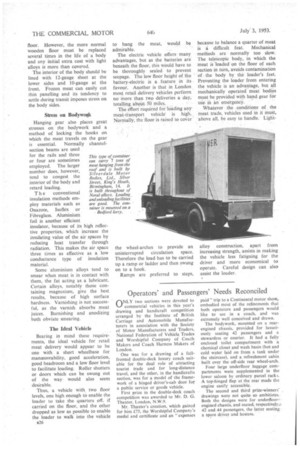Operators' and Passengers' Needs Reconciled
Page 60

If you've noticed an error in this article please click here to report it so we can fix it.
ONLY two sections were devoted to commercial vehicles in this year's drawing and handicraft competition arranged by the Institute of British Carriage and Automobile Manufacturers in association with the Society of Motor Manufacturers and Traders. National Federation of Vehicle Trades and Worshipful Company of Coach Makers and Coach Harness Makers of London.
One was for a drawing of a fullfronted double-deck luxury coach suitable for the dual role of attracting tourist trade and for long-distance travel, and the other, in the handicrafts section, was for a model of the framework of a hinged driver's-cab door for a public service or goods vehicle.
First prize in the double-deck coach competition was awarded to Mr. D. G. Thaxter, London, N.W.9.
Mr. Thaxter's creation, which gained for him £75, the Worshipful Company's medal and certificate and an "expenses paid" trip to a Continental motor show, embodied most of the refinements that both operators and passengers would like to see in a coach, and was extremely well conceived and drawn.
The bodywork, mounted on a rearengined chassis, provided for luxuriously seating 42 passengers and a stewardess or courier. It had a fully enclosed toilet compartment with a chemical closet and wash basin (hot and cold water laid on from a tank under the staircase), and a refreshment cabin built over the off-side rear wheel-arch.
Four large underfloor luggage compartments were supplemented in the lower saloon by ordinary parcel rack A top-hinged flap at the rear made the engine easily accessible.
The second and third prize-winners' drawings were not quite so ambitious. Both the designs were for underfloorengined chassis, and seated, respectively:, 42 and 44 passengers, the latter seating a spare driver and hostess.




























































































































































